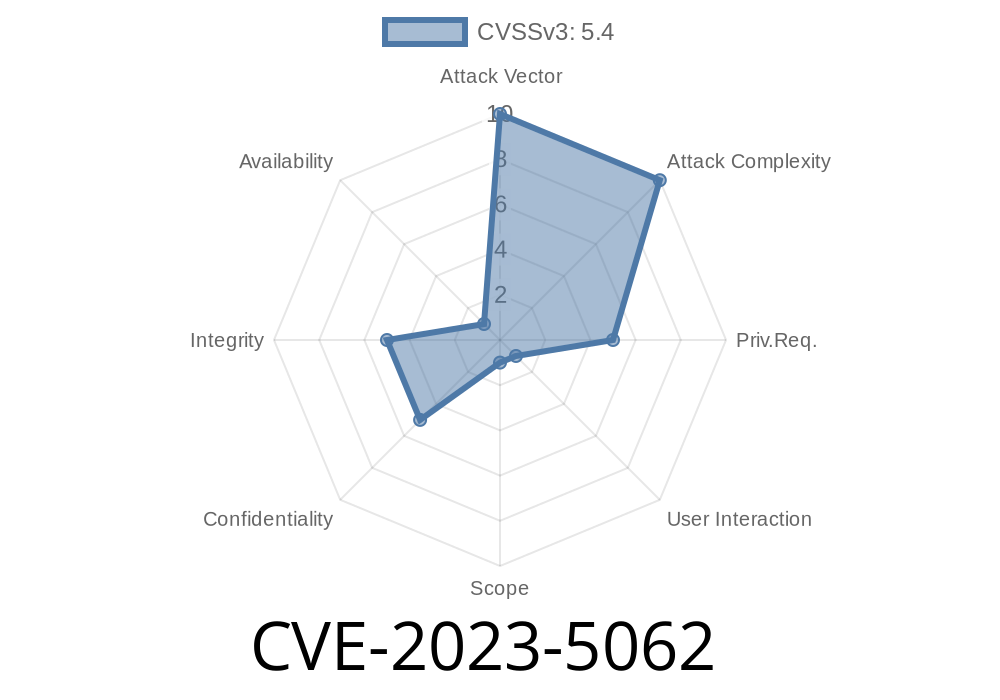The WordPress Charts plugin is a popular extension for WordPress websites that allows users to create interactive and responsive charts using simple shortcodes. Unfortunately, researchers have discovered a vulnerability in the plugin that exposes websites to the risk of Stored Cross-Site Scripting (XSS) attacks. This vulnerability is now tracked as CVE-2023-5062.
In this post, we will look at the vulnerability in detail, understand how it can be exploited, and discuss methods for mitigating the risk that it poses. We will also share a code snippet that demonstrates the vulnerability in action and provide links to the original references that document this security issue.
Vulnerability Details
The vulnerability in question affects the WordPress Charts plugin for WordPress for versions up to and including .7.. The issue lies in the insufficient input sanitization and output escaping on user-supplied attributes in the 'wp_charts' shortcode.
Due to this flaw, authenticated attackers with contributor-level and above permissions can inject arbitrary web scripts into a page that will execute whenever a user accesses the injected page. This has serious implications for the security and data privacy of users interacting with the affected websites.
Here's a code snippet that demonstrates the vulnerability
[wp_charts title="xss" type="line" datasets="1,2,3,4" labels="'';alert('XSS');"]
In this example, the attacker has exploited the lack of input sanitization and output escaping in the 'wp_charts' shortcode by injecting a JavaScript alert command within the attribute values. When unsuspecting users access the page containing this shortcode, the alert message with the text 'XSS' will be displayed, indicating that the script has executed successfully.
Exploit Details
To exploit this vulnerability, an attacker must have contributor-level or higher permissions on the target WordPress website. This means that users with lower privileges, such as subscribers or guests, are not able to leverage this issue.
Once the attacker has gained access to the site with the necessary permissions, they can create or edit a post and add the malicious 'wp_charts' shortcode that includes the arbitrary web script. Upon the page's rendering, this injected script will execute for any user that accesses the page, possibly resulting in the theft of sensitive information, user account hijacking, or other harmful actions.
To protect your WordPress website from this vulnerability, you should take the following steps
1. Update the Plugin: The first and foremost action you must take is to update the WordPress Charts plugin to the latest version, which hopefully addresses the vulnerability. Make sure to check the plugin's changelog or documentation for any relevant security updates.
2. Input Sanitization and Output Escaping: Ensure that all user inputs, including those used in plugin shortcodes, are properly sanitized and output escaped. This can help prevent harmful scripts from being injected into your site's content.
3. User Permissions: Limit the number of users with contributor-level and above permissions, and carefully vet any users who are granted these elevated privileges. By restricting the number of users able to create or edit posts, you can reduce the risk of this vulnerability being exploited.
4. Monitor and Secure Your Site: Regularly monitor your site for signs of unauthorized access or tampering, and utilize security plugins that help protect your WordPress installation from various attacks. Additionally, staying up-to-date with the latest security best practices is crucial in maintaining a secure web presence.
Original References
To learn more about the WordPress Charts plugin vulnerability (CVE-2023-5062) and its potential impact, you can consult the following resources:
1. CVE Details: CVE-2023-5062
2. WPScan Vulnerability Database: WordPress Charts Plugin .7. - Authenticated Stored Cross-Site Scripting (XSS)
Conclusion
CVE-2023-5062 is a critical vulnerability in the WordPress Charts plugin that potentially puts the security and privacy of WordPress websites and their users at risk. By understanding the details of this vulnerability and taking the necessary steps to mitigate its impact, you can keep your website safe from malicious hackers looking to exploit this issue.
Remember always to stay vigilant, keep your software up-to-date, and maintain strong security practices such as input sanitization, output escaping, and careful management of user permissions.
Timeline
Published on: 09/20/2023 03:15:14 UTC
Last modified on: 11/07/2023 04:23:25 UTC
